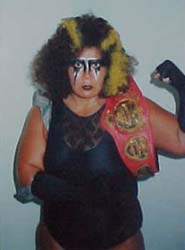In an age where women’s wrestling is more about bra and panty matches than actual grappling, the untimely and unfortunate passing of wrestling legend Rhonda Sing gives many a chance to reflect on what women’s wrestling should be.
The 5’8″, 260-pound Calgary native passed away at the age of 40 on July 27, 2001, and was a rare talent who was able to compete physically and earned the respect of her male counterparts with her ability and personality.

Monster Ripper. — photo by Jim Divito
It’s truly a pity most North American wrestling fans didn’t get to see her in her prime as the fearsome Monster Ripper who made a splash in All-Japan in the late-’70s. Sadly, most will remember her as the strangely comical Bertha Faye, the trailer park-dwelling girlfriend of Harvey Whippleman (Bruno Lauer) as part of the World Wrestling Federation’s failed women’s division in the mid-’90s.
Throughout her career, she showed an extreme amount of dedication to the sport. She had matches with some of the greatest women to step into the ring, including Bull Nakano and Wendi Richter.
Like many others in the business, Sing knew very early on that she wanted to be a wrestler. Her mother was a long-time patron of Stampede Wrestling, and she watched it regularly live and on television as a child. As a teenager, she made the decision to contact Mildred Burke and went to the women’s wrestling pioneer’s training facility in California after being rebuffed by the Harts, who did not train women at the time.
Despite spending only a few weeks under Burke’s tutelage, scouts from All-Japan wanted Sing to join them there. Her first match was a main event bout, and she and partner Mami Komeni defeated the ultra-popular Beauty Pair. In her interview with SLAM! Wrestling in January, she recalled the significance of her debut.
“It was my first match, and I won. The Japanese girls resented it because they never had to lose. If they lost, they lost to each other. They never lost to a foreigner.”
Sing had a great deal of success with All-Japan despite the difficulty in adapting to Japanese culture. After holding the promotion’s title on two occasions, she began to wrestle throughout the world and held a multitude of titles.
She returned to Calgary to work with Stampede in 1987 and was rechristened Rhonda Singh, the “h” being added by Stu Hart. According to Gama Singh (Gadowar Singh Sahota), a proposal was put forth where she would have won a “Vice Queen” contest to tie in with his Karachi Vice gimmick. Unfortunately, this idea never saw the light of day. Singh recently shared his memories with SLAM! Wrestling and had many great memories of working with Sing.
“I really thought Rhonda was a good person,” The Great Gama said. “We had been on a lot of overseas trips together. She was a good person to have around. She always kept you laughing.”
Singh had been planning a trip to the Middle East in the months prior to Sing’s death, and offered a sentiment echoed by many whose lives Sing touched.
“Rhonda’s going to be missed by a lot of people. I’m certainly going to miss her.”
Bret Hart, who was in attendance at Sing’s funeral on August 3rd, offered his memories of Sing in his recent column and also gave a brief statement to SLAM! Wrestling.
“In a very male environment Rhonda was always one of the boys and accepted by all the wrestlers,” he said. “She was a warm and giving person.”
Another long-time friend of Sing’s was Bad News Allen (Allen Coage), who toured with her several times throughout the world. He told SLAM! Wrestling she provided him with tickets to the World Wrestling Federation television taping in Calgary on May 28, and that she went backstage at the event and spoke with Shane McMahon.
“She was a hell of a talent,” said Coage. “I always thought she was one of the toughest women around. Everything she did looked believable.”
He also commented on the Bertha Faye persona she was saddled with while with the WWF in 1995.
“I hated that Bertha Faye gimmick they put on her,” he said. “I didn’t like that at all.”
A lack of support by WWF braintrust and waning fan interest in the women’s division essentially killed it a few months into her time there. Eventually she became tired of the situation, but managed to live out her dream of wrestling in Madison Square Garden. In my interview with her, Sing recalled the time with the WWF as bittersweet.
“It sort of stripped my identity,” she said “You’re going to the ring skipping and blowing kisses, looking goofy. You just went to the bank and cashed your cheque. You felt like you were pimping yourself out. You were like a prostitute for Vince. The guys were doing it too, so you know what people will do for money.”
Prior to her death, Sing had been working as a caregiver for handicapped individuals. According to her brother Tom, she had a “big heart” and “liked to look after people”. He believed there was two sides to his sister — the Monster Ripper who people saw in the ring and a caring individual who was devoted to her family.
While her family would only say that she died as a result of medical problems, donations can be made in Sing’s memory to the Heart and Stroke Foundation and to Canadian Diabetes Association.
When I conducted my interview with Sing several months ago, I had limited knowledge of her contributions to the industry. She opened my eyes to many things about sports entertainment and expressed her dissatisfaction with working on the independent circuit. Sing was without a doubt one of the greatest wrestlers to ever compete, and it is tragic how her legacy in North America is tainted by a bad gimmick. I only wish we all could remember her for the kind person she was.
May her legacy live on for future generations of wrestlers.
RELATED LINK
https://slamwrestling.net/index.php/2001/01/09/slam-wrestling-canadian-hall-of-fame-rhonda-sing-monster-ripper/












